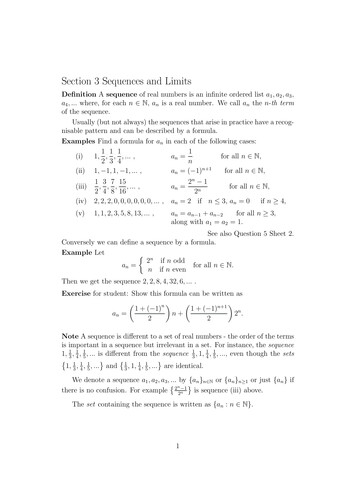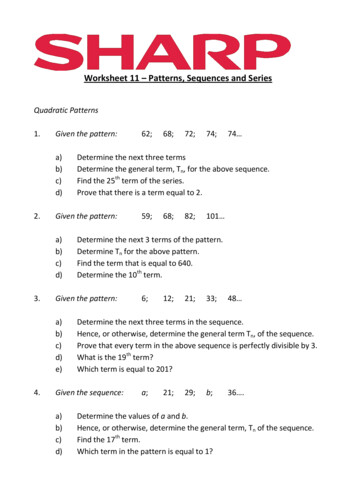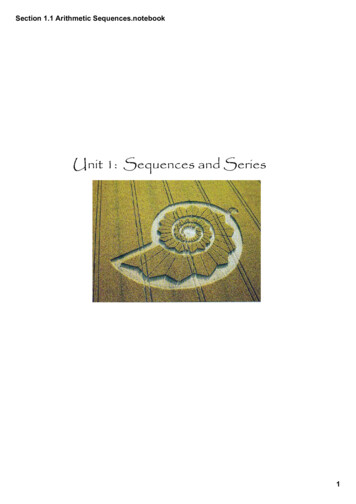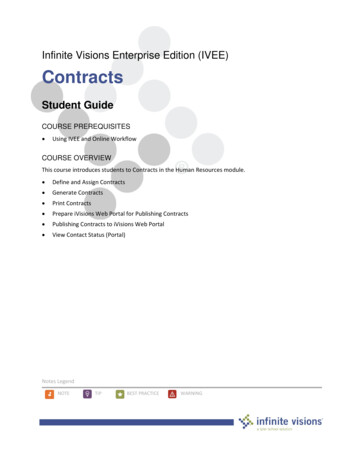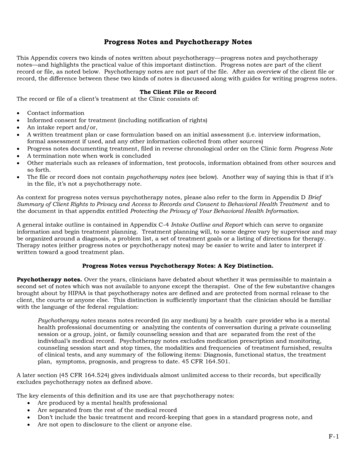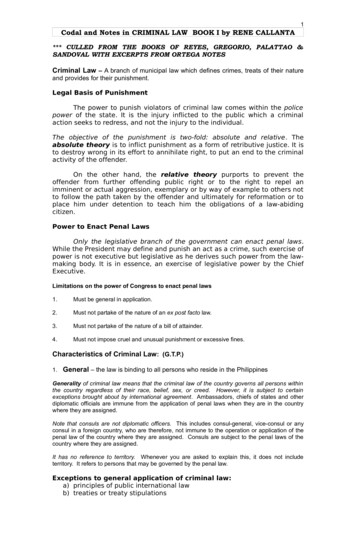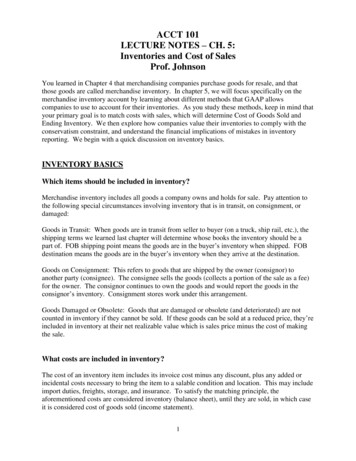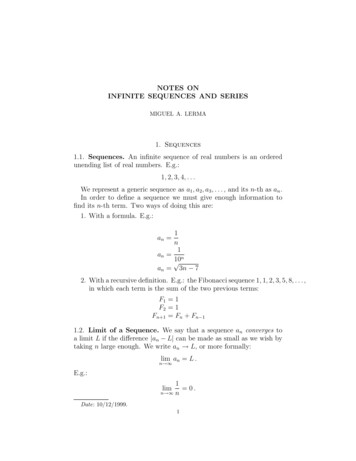
Transcription
NOTES ONINFINITE SEQUENCES AND SERIESMIGUEL A. LERMA1. Sequences1.1. Sequences. An infinite sequence of real numbers is an orderedunending list of real numbers. E.g.:1, 2, 3, 4, . . .We represent a generic sequence as a1 , a2 , a3 , . . . , and its n-th as an .In order to define a sequence we must give enough information tofind its n-th term. Two ways of doing this are:1. With a formula. E.g.:1n1an n10 an 3n 7an 2. With a recursive definition. E.g.: the Fibonacci sequence 1, 1, 2, 3, 5, 8, . . . ,in which each term is the sum of the two previous terms:F1 1F2 1Fn 1 Fn Fn 11.2. Limit of a Sequence. We say that a sequence an converges toa limit L if the difference an L can be made as small as we wish bytaking n large enough. We write an L, or more formally:lim an L .n E.g.:1 0.n nlimDate: 10/12/1999.1
2MIGUEL A. LERMAIf a sequence does not converge we say that it diverges. E.g., thefollowing sequences diverge:n 1, 2, 3, 4, · · · diverges (to )( 1)n 1, 1, 1, 1, · · · diverges1.3. Limit Laws for Sequences. If lim an A and lim bn B,n n then:lim (an bn ) A Bn lim (an bn ) A Bn lim (an bn ) A Bn lim (an /bn ) A/Bn (provided B 6 0)1 n1can be computedSo, a “complicated” limit such as L limn 3 1n10by replacing smaller parts of it with their limits 1/n 0, 1/10n 0:11 0 .L 3 031.4. Squeeze Law. If an cn bn , and an and bn have the samelimit: an L, bn L, then cn has also the same limit: cn L. Thiscan be used to compute limits such as the following one:sin n.n nlimIn this case we have:1sin n1 .nnnsin nSince 1/n 0 and 1/n 0 then 0 also.n1.5. Limits of Functions of Sequences. If an f (n) for some function f and lim f (x) L, then lim an L. This basically allows us tox nn replace limits of sequences with limits of functions. In particular this isuseful for using L’Hôpital’s rule in computing limits of sequences. E.g: enexex lim (L’Hôpital’s rule) lim .n nx xx 1lim
NOTES ONINFINITE SEQUENCES AND SERIES31.6. Bounded Monotonic Sequences. A monotonic sequence is asequence that always increases or always decreases. For instance, 1/n isa monotonic decreasing sequence, and n 1, 2, 3, 4, . . . is a monotonicincreasing sequence.A sequence is bounded if its terms never get larger in absolutevalue than some given constant. For instance 1/n is bounded, because 1/n 2 for every n, but n is unbounded.A property of any bounded (increasing or decreasing) sequence isthat it always has a (finite) limit. This might not seem very useful ifwhat we want is to actually compute the limit, but in some cases itmay help. For instance, consider the sequence defined recursively inthe following way: a1 6 , an 1 6 an(n 1) .It can be shown that an it is a bounded monotonic increasing sequence,1hence it has some limit A:lim an A .n Now, taking limits on both sides of an 1 6 an (here we use thatthe sequence has a limit) we get that A 6 A, i.e., A2 A 6 0.Solving this second degree equation we get A 3 or A 2. Sincethe sequence is positive, the limit cannot be negative, hence it must beA 3:lim an 3 .n 1.7. Homework Problems. E & P,2 11.2: 9–42, 54, 56.2. Infinite Series2.1. Series. An infinite series is an expression of the form Xn 1an a1 a2 a3 · · · , Proof: We use induction.0 a1 6 3. By adding 6 and First note that taking square roots we get 6 6 a1 6 3 3, i.e.: a1 a2 3. Nowhypothesis). Again, by addingassume an an 1 3 for a given n 1 (induction 6 and taking square roots we get 6 an 6 an 1 3, i.e. an 1 an 2 3(induction step). From here we get that an an 1 3 for every n 1, whichproves both, an is increasing and is bounded by 3.2C.H. Edwards, Jr. & David E. Penney: Calculus with Analytic Geometry, 5thedition, Prentice Hall.1
4MIGUEL A. LERMAwhere {an } is a sequence of numbers—sometimes the series starts atn 0 or some other term instead of n 1. Its Nth partial sum isSN NXan a1 a2 a3 · · · aN .n 12.2. Sum of a Series. The sumS Xann 1of a series is defined as the limit of its partial sumsS lim SN limN N NXann 1if it exists—it this case we say that the series converges. For instance,consider the following series: X1 1 11 ···n22 4 8n 1Its partial sum isNX11 1 111SN ··· N 1 N .n22 4 822n 1Hence, its sum is 1S lim SN lim 1 N 1 ,N N 2i.e.: X1 1.2nn 1A series may or may not have a sum. For instance, in the followingseries: X( 1)n 1 1 1 1 1 1 · · ·n 0the sequence of partial sums SN 1, 0, 1, 0, 1, 0, . . . diverges, and theseries has no sum.
NOTES ONINFINITE SEQUENCES AND SERIES52.3. Telescopic Series. Telescopic series are series for which all termsof its partial sum can be canceled except the first and last ones. Forinstance, consider the following series: Xn 11 111 ···n (n 1)2 6 12Its nth term can be rewritten in the following way:an 111 .n (n 1)n n 1Hence, its Nth partial sum becomes: NN XX111 SN n (n 1) n 1 n n 1n 1 111 11 11 ··· 1 22 33 4NN 11. 1 N 1Hence: X11 1. lim 1 n (n 1) N N 1n 12.4. Geometric series. A geometric series Xan is a series in whichn 0each term is a fixed multiple of the previous one: an 1 r an , where ris called the ratio. A geometric series can be rewritten in this way: Xa rn a a r a r2 a r3 · · · .n 0If r 1 its sum is Xn 0a rn a.1 rNote that a is the first term of the series. If a 6 0 and r 1, theseries diverges.Examples:X 111 1 1 1 ··· n22 4 81 n 012 2.
6MIGUEL A. LERMAX ( 1)nn 02n 1 121 1 1 ··· .1 2 4 831 ( 2 )Note that in the last example r an 1 /an ( 1)n 1 /2n 1( 1)n /2n 1/2.2.5. Termwise addition and multiplication of series. Ifand X Xan An 1an B thenn 1 X(an bn ) n 1 Xan n 1 Xbn A Bn 1and Xc an cn 1 Xan c A ,n 1where c is a constant.2.6. The nth Term Test for Divergence. If an does not converge Xto 0, thenan does not converge—Note: the reciprocal is not truen 1in general! (a counterexample is the harmonic series; see below.) XFor instance, the seriessin n does not converge because sin n doesnot converge to 0.n 12.7. The Harmonic Series. The series X1 1 11 1 ···n2 3 4n 1is called harmonic series.The harmonic series diverges. This can be proven graphically, bylooking at the graph of the function f (x) 1/x (fig. 1). The termsof the harmonic series are the areas of the rectangles. Their sum isgreater than the area under the graph of f (x) 1/x between 1 and , which can be computed with the following improper integral:Z Z M11dx limdx lim [ln x]M(ln M ln 1) .1 MlimM M xx11
NOTES ONINFINITE SEQUENCES AND SERIES71.41.2y 1/x10.80.60.40.21011/221/3x31/445Figure 1. The harmonic seriesHence, X1 .nn 12.8. Series that are Eventually the Same. If an bn for every n XXlarge enough, then the seriesan andbn either both converge orn 1n 1both diverge. In other words, the convergence or divergence of a series Xan .depends only on its “tail”n k2.9. Homework. E & P, 11.3: 1–37, 49, 50, 64. Maple Worksheet:WS1 (due 10/7/99).3. Taylor Series and Taylor Polynomials3.1. Linear Approximation of a Function. Assume that we wantto compute the value of a function such as sin 0.1 or ln 1.1. Evaluatingpolynomials is easy, it can be accomplished by a sequence of computations involving only arithmetic operations ( , , ). For instance, iff (x) x2 7x 2 then f (3) 32 7 3 2 32. For other functionsin general we may not be able to evaluate them exactly, but we can
8MIGUEL A. LERMAdo it approximately. A first approximation consists of substituting thegraph of the function by a tangent line (fig. 2).10.5P1(x) c0 c1 (x-a)y ure 2. Linear approximationThe equation of the tangent line at x a isP1 (x) c0 c1 (x a) .Also, the following conditions must be met:P1 (a) f (a)P10 (a) f 0 (a)i.e., the tangent line must pass through the point (a, f (a)), and itsslope should be the derivative of f (x) at x a. From here we get:c0 f (a)c1 f 0 (a)hence the tangent line and first approximation of f (x) at x a isP1 (x) f (a) f 0 (a) (x a) .P1 (x) is called the 1st-degree Taylor polynomial of f (x) at x a.For instance, if f (x) ln x then its first-degree Taylor polynomialat x 1 is1P1 (x) ln 1 (x 1) x 1 .1
NOTES ONINFINITE SEQUENCES AND SERIES9Henceln x x 1for x close to 1. In particular ln 1.1 1.1 1 0.1. Compare to theactual value ln 1.1 0.095310179 . . . .3.2. Higher Degree Polynomial Approximations. The linear (firstdegree) polynomial approximation might be enough for many practicalpurposes, but sometimes we need a better approximation. This can beaccomplished by using higher degree polynomials.The nth degree Taylor polynomial of a function f (x) at x a is apolynomial of the form:Pn (x) c0 c1 (x a) c2 (x a)2 · · · cn (x a)nnX ck (x a)kk 0whose value and derivatives up to the nth are equal to those of f (x)at x a, i.e.:Pn (a) f (a)Pn0 (a) f 0 (a)Pn00 (a) f 00 (a).(nPn (a) f (n (a)Solving those equations we get that ck f (k (a)/k!, hence the nthdegree Taylor polynomial of f (x) at x a isf 00 (a)f (a) f 0 (a)f (n (a) (x a) (x a)2 · · · (x a)n0!1!2!n!nXf (k (a)(x a)k . k!k 0Pn (x) For instance, for f (x) ln(x) and a 1 we getP2 (x) (x 1) 1(x 1)2 ,2hence, ln 1.1 (1.1 1) 12 (1.1 1)2 0.095, closer to the actual valueln 1, 1 0.095310179 . . . than the first degree approximation computedabove.
10MIGUEL A. LERMA3.3. Taylor series. The next logical step is to use an “infinite”-degreepolynomial, i.e., a series of the form: Xf (k (a)k 0k!(x a)k .This series is called the Taylor series of f (x) at x a. If a 0 thenthe Taylor series is called Maclaurin series.A function f (x) such that1. its Taylor series converges, and Xf (k (a)2. f (x) (x a)k ,k!k 0is called analytic. A few examples of analytic functions are the following: Xx2 x3xnxe 1 x ··· 2!3!n!n 0 Xx2 x3xn ··· ( x 1)( 1)n 1ln (1 x) x 23nn 1 2n 1Xx3 x5n xsin x x ··· ( 1)3!5!(2n 1)!n 0 24Xxxx2n ··· ( 1)ncos x 1 2!4!(2n)!n 0 X1 1 x x2 x3 · · · ( 1)n xn( x 1)1 x n 0 Xα nααα 2α 3αx(1 x) x x x ··· n0123n 0( x 1) (n factors)α (α 1) (α 2) . . . (α n 1)αwhere .nn!As an example, the Taylor series for ex can be used for computingthe number e: X111 1 1 · · · 2.718281828 . . .e e n!2! 3!n 013.4. Homework. E & P, 11.4: 11–20, 23–25, 29–40.
NOTES ONINFINITE SEQUENCES AND SERIES114. The Integral Test.In section 2.7 we found that the harmonic series diverges by comparing its sum with an integral (see fig. 1). This technique is calledintegral test. More generally we have that the following holds:P4.1. Integral Test. Suppose n 1 an is a positive-term series (i.e.,an 0 for every n 1, 2, 3, . . . ). Also assume that f (x) is a positivevalued, decreasing, continuous function for x 1 such that an f (n) Xfor every n 1, 2, 3 . . . . Then the seriesan and the impropern 1Z integralf (x) dx either both converge or both diverge.1So, in order to test the series for convergence it is enough to test thecorresponding integral for convergence, which in many cases is easier.The next one is a typical example of application of the integral test.4.2. p-Series. A p-series is a series of the form: X1,npn 1where p 0 is a fix exponent.The case p 1 is the harmonic series, which was shown to be divergent in section 2.7. On the other hand, if p 6 1: 1 p MZ M 11xM 1 p 1 .dx px1 p 11 p1As M the limit of the above expression converges for p 1,and diverges for p 1. Hence, the integral test shows that the p-seriesconverges for p 1, and diverges for p 1.4.3. Homework. E & P, 11.5: 1–30, 35–38.5. Comparison Test for Positive-Term SeriesThe comparison test allows us to test a series for convergence bycomparing it to another series for which convergence is easier to test.It says the following:PP5.1. Comparison Test. Supposean andbn are positive-termseries such that an bn for every n. Then:PP1. If P an diverges then Pbn diverges.2. Ifbn converges thenan converges.
12MIGUEL A. LERMAFor instance, consider the series X1 .3n 1n 1 Since 1/ n3 1 1/ n3 1/n3/2 , the convergence of the given seriescan be derived from the convergence of the following series: X1.3/2nn 1This is a p-series with p 3/2 1, hence it converges, and so does thegiven series.In some cases the ordinary comparison test is hard to apply, but thefollowing is easier to use:PP5.2. Limit Comparison Test. Supposean andbn are positiveterm series, and the limitanL limn bnexists and is not zero nor infinity: 0 L . Then either bothseries converge or both diverge.For instance, look at the following series: X2 3n .n3 n 1n 1We can test its convergence by limit comparison with the harmonicseries: X1.nn 1In fact:lim(2 n 3n)/ n3 n 1 3,1/nwhich is not zero nor infinity. Since the harmonic series diverges, weconclude that the given series also diverges.5.3. Rearrangement and grouping. In a positive-term series rearranging and regrouping its terms does not alter its sum. Note that thisis not true in general for other series. For instance, the following seriesis divergent:1 1 1 1 1 1 ··· .
NOTES ONINFINITE SEQUENCES AND SERIES13However, if we regroup its terms in the following way, we get a convergent series with zero sum:(1 1) (1 1) (1 1) · · · 0 0 0 · · · 0 .A different regrouping still give us a different sum:1 ( 1 1) ( 1 1) ( 1 1) · · · 1 0 0 0 · · · 1 .However, if the terms are all positive, then we can rearrange andregroup them without any fear of changing the sum. So, for instance:X 11 1 111/2 ··· 1. n2 4 8 1621 1/2n 1Now, if we regroup its terms in the following way, we get: X 11333/41 11 ··· ··· 1,3 n 2 48 164 1641 1/4n 1so, we get the same sum.5.4. Homework. E & P, 11.6: 1–36.6. Alternating Series and Absolute ConvergenceAn alternating series is a series of the form X( 1)n 1 an a1 a2 a3 a4 · · ·n 1or X( 1)n an a1 a2 a3 a4 · · ·n 1where an 0 for every n. Examples: the alternating harmonic series: X( 1)n 1n 11 1 11 1 ··· ;n2 3 4an alternating geometric series: Xn 0( 1)n1 1 11 1 ··· .n22 4 8
14MIGUEL A. LERMA6.1. Alternating Series Test. If an alternating series verifies:1. an it is decreasing: an an 0 for every n, and2. the nth term tends to zero: limn an 0 ,then the series converges.So, in this particular case the “reciprocal” of the nth term test holds.E.g.: X( 1)n 1nn 1 X( 1)n 1n 02n 1 1 1 1 1 · · · ln 22 3 4 1 1 1 1π ··· .3 5 746.2. Alternating Series Remainder Estimate. Let S be the sumof an alternating series: XS ( 1)n 1 an ,n 0and SN its Nth partial sum:SN NX( 1)n 1 an .n 0Then the difference RN S SN (remainder) between the sum ofthe series and that of the Nth partial sum has the same sign as thefollowing term of the series ( 1)n 2 an 1 , and0 RN an 1 .In particular, S is always between two consecutive partial sums.For instance, we know that X( 1)n 1,π 42n 1n 0but how close do we get to π by adding, say, one hundred terms of thatseries? Answer: its sum π is between99X( 1)n 14 3.131592904 . . .2n 1n 0and4100X( 1)n 1n 02n 1 3.151493401 . . .
NOTES ONINFINITE SEQUENCES AND SERIES15Compare to the actual value π 3.141592654 . . . .Pbe ab6.3. Absolute Convergence. A general seriesan is said to Psolutely convergent if the series of absolute values of its terms an is convergent.We have that a series can be:1. Convergent and absolutely convergent, e.g: n X11 1 1 1 ···22 4 8n 02. Convergent but not absolutely convergent—in this case the seriesis called conditionally convergent—, e.g: X( 1)n 1n 1n 1 1 1 1 ···2 3 43. Not convergent nor absolutely convergent, e.g: Xn 1 2 3 4 ···n 1However, a series cannot be absolutely convergent and not convergent, because absolute convergence implies convergence:absolute convergent convergentExample: Does the series Xcos nn 1n2series of absolute values: X cos n n 1n2 converge? Answer: Look at the X1.2nn 1By comparison test, it converges (the right hand side is a p-series withp 1), hence the given series is absolutely convergent, which impliesthat it is indeed convergent.6.4. Ratio Test. Suppose that the limit ρ limn infinity. ThenP1. If ρ 1 P an converges absolutely.2. If ρ 1 an diverges.3. If ρ 1 the ratio test is inconclusive.an 1exists or isan
16MIGUEL A. LERMAAs a rule of thumb, for geometric series ρ r (the ratio), and theconclusion of the ratio test is analogous to the one for geometric series,i.e., the series converges for r 1 and diverges for r 1. Xn2Example: For the serieswe haven2n 1ρ limn an 11(n 1)2 /2n 1(n 1)2 lim lim 1,2n2n n ann /22n2hence, it converges absolutely.36.5. Root Test. In some cases in which the ratio test is unable to provide an answer, the rootptest may help. It says the following: Supposethat the limit ρ lim n an exists or is infinity. Thenn P1. If ρ 1 P an converges absolutely.2. If ρ 1 an diverges.3. If ρ 1 the root test is inconclusive. X1Example: Consider the following series. For this seriesn sin n2n 1the ratio test cannot be used, because11an 1 2 1 sin n sin (n 1) 2 1 2 sin 2 cos (n 2 )anwhich has no limit. However, the root tests shows that the series isabsolutely convergent:r111nlim 1. lim n 2n sin n n 21 sin n/n26.6. Homework. E & P, 11.7: 1–42.7. Power SeriesA power series is a sort of infinite polynomial of the form Xan xnn 0Taylor series are particular cases of power series. E.g.: Xx2 x3xnx 1 x ···e n!2!3!n 03The sum is exactly Xn2 6.2nn 1
NOTES ONsin x X( 1)nn 0 XINFINITE SEQUENCES AND SERIES17x3 x5x2n 1 x ···(2n 1)!3!5!x2 x4x2ncos x 1 ···( 1)(2n)!2!4!n 0 X1 ( 1)n xn 1 x x2 x3 · · ·1 x n 0n( x 1)7.1. Convergence of a Power Series. The first question we mustanswer about a powers series is “for what values of x does the seriesconverge?” This can be answered with the ratio test:ρ limn an 1 xn 1an 1 x , x lim n an xnanRwherean 11 lim.R n an(If the limit is zero then we take R . If it is infinity then R 0.)We know that the series converges absolutely if ρ 1, i.e., x 1,R x and diverges if ρ 1, i.e., R 1. Hence the series converges absolutelyfor x R, i.e., on the interval ( R, R), and diverges for x R. Thenumber R is called the radius of convergence of the series.It remains to determine if the series converges at the endpoints x Rand x R. This can be answered by substituting x R and x Rin the power series and studying the resulting series. After doing that,we will find that the interval of convergence is one of the following:( R, R) ,[ R, R) ,( R, R] or [ R, R]If R then the interval of convergence is the whole real line R.Example: consider the Maclaurin series for ln(1 x): Xn 1( 1)nn 1 xn.Using the ratio test we get:ρ limn xn 1 /(n 1)n lim x x .nn x /nn 1Hence the series converges absolutely for x 1 and diverges for x 1. It remains to study the endpoints x 1.
18MIGUEL A. LERMAFor x 1 the power series becomes X1( 1)n 1 ,nn 1which is the alternating harmonic series. We know that it converges.For x 1 the power series becomes X1 ,nn 1which is the (usual) harmonic series. We know that it diverges.Hence the interval of convergence is ( 1, 1].7.2. Power Series in Powers of (x c). The same techniques canbe applied to power series of the form: Xan (x c)nn 0Using the ratio test we getρ limn an 1 (x c)n 1an 1 x c , x c lim nn an (x c)anRwherean 11 lim.R n anHence the series converges absolutely if x c 1 and diverges ifR x c 1. In other words, it converges absolutely for x c R, i.e.,Ron the i
1.4. Squeeze Law. If a n c n b n,anda nand b n have the same limit: a n! L, b n! L,thenc nhas also the same limit: c n! L.This can be used to compute limits such as the following one: lim n!1 sinn n: In this case we have: 1 n sinn n 1 n: Since 1 n ! 0and1 n ! 0then sinn n! 0also. 1.5
